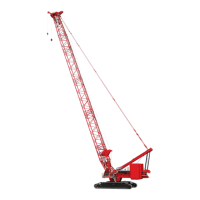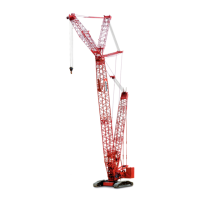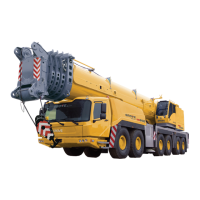SWING SYSTEM MLC300 SERVICE/MAINTENANCE MANUAL
6-2
Published 11-22-17, Control # 257-02
SWING OPERATION
Swing Pump Control
Swing pump 5 is controlled by an electronic displacement
control (EDC). The EDC is a proportional solenoid valve that
determines the swing pump’s output volume and flow
direction.
When a swing command is communicated to the IOLC31
control module via the CAN Bus, the IOLC31 control module
sends a pulse-width modulation (PWM) output signal to the
EDC. The PWM consists of a 1.6 to 8.8 V
DC
signal with the
current control range starting at 200 mA and ending at
600 mA.
The PWM signal is proportional to the speed commanded by
the position of joystick J1. Increasing the PWM duty cycle
routes more hydraulic fluid to the swashplate servo piston,
increasing the swashplate angle. As the swashplate angle
increases, so does the piston stroke within the pump,
increasing pump output volume.
Swing Left
When joystick J1 is moved to the left, the joystick sends a
swing left command to CCM-10 control module via CAN Bus
A. The CCM-10 control module relays the command to the
IOLC31 control module via CAN Bus C. The IOLC31 control
module then ramps up the PWM duty cycle to the
proportional solenoid A in the swing pump EDC to move the
pump swashplate to a position that meets the direction and
speed commanded by the joystick position.
The swing pump sends hydraulic fluid out port B on the pump
to port B on the motor. Hydraulic fluid then flows from port A
on the motor to port A on the pump to complete the closed-
loop circuit.
The swing motor speed sensor and swing left psi pressure
transducer provide closed-loop feedback to the CCMC11
control module.
Cross Port Orifice
The orifice across the A and B sides of the closed loop
provides smoother hydraulic fluid flow when shifting swing
directions.
Swing Right
When joystick J1 is moved to the right, the joystick sends a
swing right command to CCM-10 control module via CAN
Bus A. The CCM-10 control module relays the command to
the IOLC31 control module via CAN Bus C. The IOLC31
control module then ramps up the PWM duty cycle to the
proportional solenoid B in the swing pump EDC to move the
pump swashplate to a position that meets the direction and
speed commanded by the joystick position.
The swing pump sends hydraulic fluid out port A on the pump
to port A on the motor. Hydraulic fluid then flows from port B
on the motor to port B on the pump to complete the closed-
loop circuit.
The swing motor speed sensor and swing right psi pressure
transducer provide closed-loop feedback to the CCMC11
control module.
Coasting
When joystick J1 is moved back to the neutral position, the
IOLC31 control module ramps down the PWM signal to the
energized A or B solenoid in the pump 5 EDC. This allows
the springs to center the spool inside the proportional
solenoid valve, causing the pump swashplate to destroke
(moves to the center position), stopping hydraulic flow to the
motors.
With joystick J1 in the neutral position and the swing brake
released, the crane is allowed to coast because of an orifice
located across the A and B sides of the closed loop. The
orifice is connected in parallel with ports A and B of the swing
motor, allowing a restricted amount of hydraulic fluid to flow
from one side of the motor to the other side without having to
go through the pump.
Swing Alarm
Whenever a PWM signal is sent to the EDC on pump 5, the
CCMC11 and IOLC34 control modules activate the front and
rear alarms.

